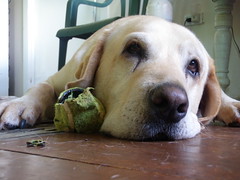The story continues happily.
First some background on Wonton, the pug. Now 6 yrs old Wonton has been suffering from seizures for 4 years. That’s most of his young life. They are grand mals that happen about once every two weeks. He also has some chronic dermatitis, with much rubbing of his face and licking of his paws. Very uncomfortable. He has had multiple adverse vaccine reactions – acute facial swelling, generized pruritis, rashes, hives, urticaria. He has also suffered from chronic otitis (ear infections) treated palliatively with topical corticosteroid/antibiotic ointments. His personality remains true to his breed – happy, sweet, bright.
His treatment included a customized supplement protocol, a grain-free home-prepared diet to correct his dysbiosis (poor bacterial mix in his stomach and intestines) and the homeopathic drug Thuja occidentalis. You might notice this is the same hp rx as for Arden, our other seizure case in this blog thread. This is just coincidence. Supplements included a good multivitamin (most multivits on the market are poor quality), and another to help with the environment in his GI tract. This is very important. The environment in the stomach and intestines will dictate the environment in the rest of the body, including even the brain.
First Follow Up Appointment – 3.14.11
Amazing! Wonton’s owner, Jenna, has been seizure free for the first time since he was two yrs old! It has been six weeks. He should have had three in that time frame. Once he showed signs of starting one but it never came. I have been a doctor in practice for 26 years and practicing homeopathy for 24. I am still amazed and delighted like a child every time I see results that seem so miraculous like this.
Understand that the homeopathic drug did not do what conventional drugs do. The Thuja did not suppress the seizure chemistry, or alter the brain chemistry in any way. All it did was stimulate Wonton to change it, to correct it himself! Like a coach that trains an athlete, Thuja gave the instructions and Wonton’s body did the work. This is why homeopathy can truly be called curative. Once a patient’s body returns itself to normal chemistry, a state called homeostasis, it tends to stay there. Homeostasis is the default for body function. That is why, when done properly, there is no need for homeopathic treatment after cure is reached. The body is in “balance” and tends to stay there.
Wonton’s paw licking has also decreased by approx. 90%. He used to lick for 20 minutes at a time. Now it is just 1-2 minutes. That’s a huge difference. There was an aggravation of his occassional tendency to vomit. He had one week where he vomited three times. A typical flare up of symptoms during a move toward cure.
This is a very promising beginning for Wonton!
The Thuja dose was increased and a recheck set for one month.

